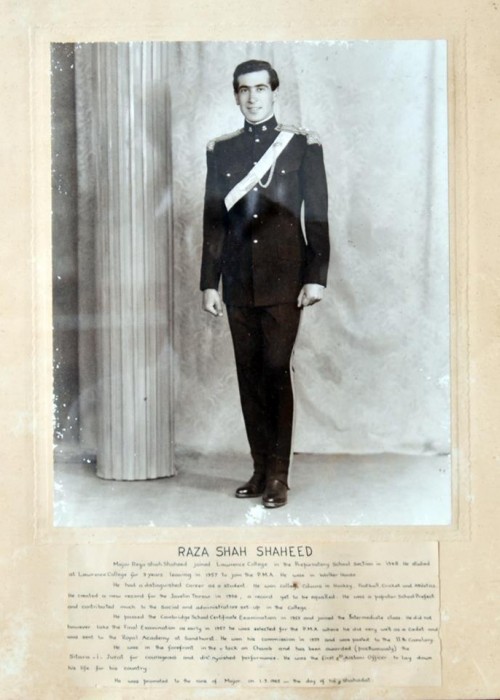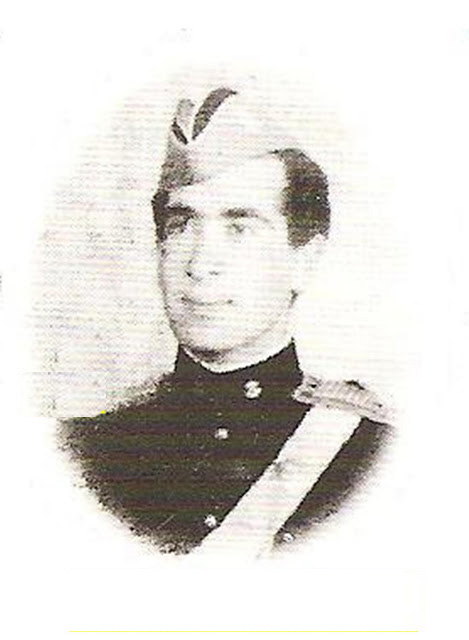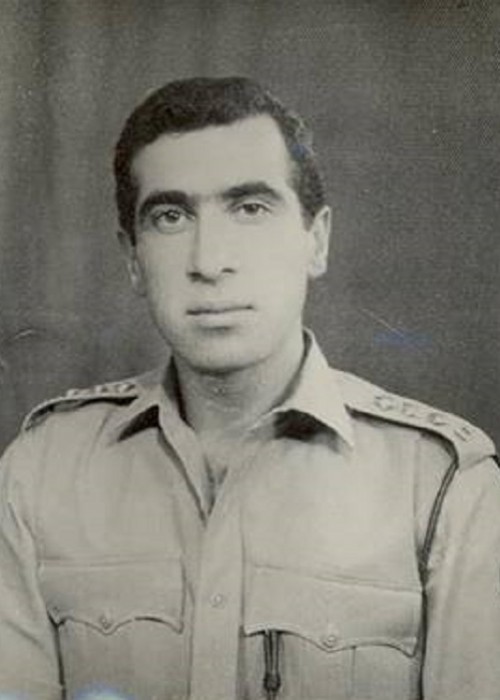War takes away the best men , the most handsome men , as well as the most gifted men.
Two of these handsome as well as outstanding men were Major Mian Raza Shah , Sandhurst Commissioned from my regiment and Major Z U Abbasi – A H Amin
Major Mian Raza Shah SJ, belonged to the famous Kaka Khel family of Village Sardar Killi, Umerzai, Charsadda. Raza Shah started his early schooling in Islamia High School, Peshawar and subsequently joined prestigious Lawrence College, Ghora Gali, Murree in Wightwick House. He made his mark in academics and sports earning College Colours and setting a record for the longest Javelin throw, a record yet to be broken.
Raza Shah heads the list of Martyrs (Shaheeds) on the War Memorial at Lawrence College, erected in honour of the gallant Gallians who laid down their lives for the country.
Maj Shah was the first Pakistani officer to embrace shahadat in the 1965 Indo-Pak war. He was initially recommended for Nishan e Haider, the highest military award, but was subsequently awarded Sitara e Jurat (Medal of Courage).
In May 1957, Raza Shah joined Pakistan Army as a gentleman cadet of 20 PMA Long Course at the Pakistan Military Academy, Kakul. At the time, Pakistan used to send one cadet from every course for training at the Royal Military Academy, Sandhurst, United Kingdom. Raza Shah earned this honour. He justified his selection and became a member of the Academy’s Hockey and Football teams. And, at the end of his training he was awarded the “Overseas Cane” for overall best performance by an allied cadet.
Commissioned in Pakistan Army on 18 October 1959, Raza Shah joined 11th Cavalry (Frontier Force) at Nowshera. About two years later the Shah of Iran, Raza Shah Pehalvi visited Pakistan and attended the festival of Horse and Cattle Show at Fortress Stadium, Lahore. A chosen group of young subalterns, Raza Shah included, was introduced to the Royal dignitary. The Shah of Iran was surprised when this handsome cavalry officer introduced himself as lieutenant Raza Shah. “Oh really”, was the spontaneous remark by Shah of Iran.
In late August 1965, he was assigned the command of C (Charlie) Squadron, 11 Cavalry, equipped with M36B2’s, a problematic turret-less tank not known for envious technical performance. To give the coveted command of a difficult squadron to an officer so young reflected the confidence that his commanding officer had in Raza Shah.
When the Indians had captured the Haji Pir Pass in Azad Kashmir by 28 August 1965, and were threatening Muzafarabad, the Pakistan Army launched a counter offensive on 1 September 1965 across the cease-fire line to relieve pressure on our forces defending Muzafarabad. The objective of this counter offensive was Chamb, Jourian and Akhnoor in Indian Held Kashmir.
On the eve of battle, the just appointed squadron commander, Captain Raza Shah bubbling with confidence and excitement gave a pep talk to his troops poised for combat the following day. “Tomorrow we shall Inshallah go into battle against a wicked enemy”, said Raza Shah adding, “Those of you who know me will find me leading the front. And, those who do not know me yet shall not fail in discovering me.” Raza Shah proved to be a man of his words.
Captain Raza Shah, was given the objective to capture Chak Pandit, a village south of Chamb, in the first phase of the battle. The enemy had very strong defences in the area and had well entrenched tanks and anti-tank weapons.
As the battlefield shivered with machine-gun fire, thundering of tank guns and artillery bombardment, Raza shah, undeterred, continued with a steady advance destroying several enemy tanks and positions in the process.
His steadfast perseverance in battle and unyielding commitment for maintaining the momentum of attack without regard to his personal safety in the battlefield littered with hostile fire showed his character, courage and gallantry beyond the call of duty in keeping with the highest traditions of cavalry and Pakistan Army.
By 10:00 am, the objective given to his squadron was within the firing range of its tanks, and a few minutes separated him from his operational goal. Suddenly his own tank was hit by the fire of an enemy Recoilless Rifle hiding in the brick kiln close to village Chak Pundit. All the crew-members of the tank, barring its driver, Ghulam Khan, were caught in the intense inferno that instantly raged in the tank. It precluded any chance of evacuation from the burning tank or escape from fire. Ghulam Khan, the only eyewitness in the episode, sustained burn injuries and was evacuated for treatment. Raza met his Creator at the young age of 28 and was the first officer to have embraced shahadat on 1 Sept 1965. Along with Major Raza Shah, 19 other ranks of 11 Cavalry Regiment made the supreme sacrifice on the first day of this battle plus another 15 from this regiment embraced shahadat before the ceasefire took place.
Mian Raza Shah was a Captian in September 1965 and was promoted to the Major rank after embracing shahadat.
On 23 March 1966, President Mohammad Ayub Khan delivered Raza Shah’s richly deserved gallantry award of Sitara-i-Jurrat to his father Mian Firdos Shah. It now adorns the quarter guard of the regiment that once had the pleasure of welcoming him in its fold. Major Raza Shah’s portrait and ceremonial uniform enrich the officer’s Mess of 11th Cavalry Regiment. His younger brother Lt Col Mian Liaquat Shah commanded 11 Cavalry in late 1980s.
Source: Defence.pk
A war hero to remember
By General Khalid Mahmud Arif
For the people of Pakistan, 6 September is a day of recollection, reflection and rededication. It reminds them year after that freedom bears a price tag and nations ready to offer sacrifices for preserving their sovereignty live with respect and honour. And, those valiant men and women in uniform who perform untarnishable acts of valour beyond the call of normal duty and offer supreme sacrifice in defence of their motherland become immortals. Such awe-inspiring privileged few are remembered in history with respect. One such officer was Major Mian Raza Shah (1937-1965) martyred in India-Pakistan War 1965, to live eternally. The Holy Quran (Al-Imran 169) say
‘Think not of those
Who are slain in God’s way
As dead. Nay, they live,
Finding their sustenance
In the Presence of their Lord;’
The scion of a renowned Kakakhel family from the Frontier Province, Raza Shah was the third child and second son of Mian Firdos Shah, a resident of Village Sardar Killi, Umerzai, Charsadda. A darling of his father, Raza Shah, was a gifted and well-groomed lad from childhood, ever pulsating with life and bravado, and never shy in getting into pranks, much to the chagrin of his affectionate parents.
Raza started his early schooling in Islamia High School, Peshawar and subsequently joined prestigious Lawrence college, Ghora Gali, Murree, one hour’s drive by road from the capital city, Islamabad. He made his mark in academics and sports earning College colours and setting a record for the longest Javelin throw a record, yet to be broken. His name heads the list of Martyrs (Shaheeds) on the War Memorial at Lawrence College, erected in honour of the gallant Gallians who laid down their lives for the country.
In May 1957, Raza Shah joined Pakistan Army as a gentleman cadet at the Pakistan Military Academy, Kakul. At the time, Pakistan used to send one cadet from every course for training at the Royal Military Academy, Sandhurst, United Kingdom. Raza Shah earned this honour. He justified his selection and became a member of the Academy’s Hockey and Football teams. And, at the end of his training he was awarded the “Overseas Cane” for overall best performance by an allied cadet.
Commissioned in Pakistan Army on 18 October 1959, Raza Shah joined 11th Cavalry (Frontier Force) at Nowshera. About two years later the Shah of Iran, Raza Shah Pehalvi visited Pakistan and attended the festival of Horse and Cattle Show at Fortress Stadium, Lahore. A chosen group of young subalterns, Raza Shah included, was introduced to the Royal dignitary. The Shah of Iran was surprised when this handsome cavalry officer introduced himself as lieutenant Raza Shah. “Oh really”, was the spontaneous remark by the monarch.
Raza Shah completed his special to arm technical training with such credit that in February 1964 he was posted as gunnery instructor in the School of Amour. The impending war hysteria created by India curtailed the full tenure of his instructional assignment. He rejoined his unit in May 1965 and was given command of Reconnaissance Troop. In late August 1965, he was assigned the command of C (Charlie) Squadron equipped with M36B2’s, a problematic turret-less tank not known for envious technical performance. To give the coveted command of a difficult squadron to an officer so young reflected the confidence that his commanding officer had in Raza Shah.
11th Cavalry (FF), under command 102 Brigade, was tasked to capture Chhamb, a town located in the southern part of the disputed State of Jammu and Kashmir. On 31 August 1965, this unit was located at Kotla, a village near Bhimbar. On the eve of battle, the just appointed squadron commander, Captain Raza Shah bubbling with confidence and excitement gave a pep talk to his troops poised for combat the following day. “Tomorrow we shall Inshallah go into battle against a wicked enemy”, said Raza Shah adding, “Those of you who know me will find me leading the front. And, those who do not know me yet shall not fail in discovering me.” Raza Shah proved to be a man of his words.
All pre-combat final checks completed, 11th Cavalry (FF) left its concentration Area on night 31st August/1 September and tanks started advancing towards the selected Start Line, about five kilometres away. Gradually night melted away into dawn. As the early morning rising sun emitted rays of light, the tanks maintained their steady forward movement despite considerable rough going. Tanks crossed the Cease-fire Line and the unit was now operating in the enemy territory. Raza Shah’s old Vintage tank stalled tank and pursued with the attack. The momentum of movement was slower than anticipated a phenomenon not uncommon in combat. As tanks approached Tawi River, Raza Shah’s Squadron came within the firing range from Chak Pundit. An intense exchange of fire ensued between the opposing forces. Raza Shah kept his nerves cool and repeatedly advised his tank commanders to move with speed and strike with aggression.
As the battlefield shivered with machine-gun fire, thundering of tank guns and artillery bombardment, another misfortune struck Raza Shah. His tank developed a mechanical problem. He left his crew members to attend to the fault and, disregarding his personal safety, jumped into the tank of Naib Risaldar Atta Mohammad (Haideri) to continue with his assigned mission. His steadfast perseverance in battle and unyielding commitment for maintains the momentum of attack without regard to his personal safety in the battlefield littered with hostile fire showed his character, courage and gallantry beyond the call of duty in keeping with the highest traditions of cavalry and Pakistan Army.
By 10:00 am, the objective given to his squadron was within the firing range of its tanks, and a few minutes separated him from his operational goal. Suddenly his own tank was hit by the fire of an enemy Recoilless Rifle hiding in the brick kiln close to village Chak Pundit. All the crew-members of the tank, barring its driver, Ghulam Khan, were caught in the intense inferno that instantly raged in the tank. It precluded any chance of evacuation from the burning tank or escape from fire. Ghulam Khan, the only eyewitness in the episode, sustained burn injuries and was evacuated for treatment. Raza met his Creator at the young age of 28.
Raza Shah, promoted posthumously to the rank of Major was recommended for the award of Nishan-e-Haider, the Highest gallantry award in the country. He was awarded Sitara-i-Jurat. His mortal remains were buried as Amanat in the battlefield. In March 1966, Pakistan Army delivered these in a sealed coffin to the bereaved relatives in village Sardar Killi for burial. On this occasion of extreme emotional distress and despite his intense personal pain, Raza Shah’s father felt, ‘proud of my son’s Shahadat.’ His mother’s thoughtful comment was, ‘perhaps Allah liked my son so much that he lifted him body and should to Heaven where Shaheeds dwell.’
Liaquat Shah (Later Lieutenant-Colonel), Raza’s brother drove his sister to the graveyard to witness the burial ceremony. While travelling she looked at the blooming spring flowers en route and remarked, ‘The smiling flowers welcome the arrival of the remains of a distinguished son of the soil to his village.’ On 23 March 1966, President Mohammad Ayub Khan delivered Raza Shah’s richly deserved gallantry award of Sitara-i-Jurrat to his father Mian Firdos Shah. It now adorns the quarter guard of the regiment that once had the pleasure of welcoming him in its fold. Major Raza Shah portrait and ceremonial uniform enrich the officer’s Mess of 11th Cavalry (FF).


